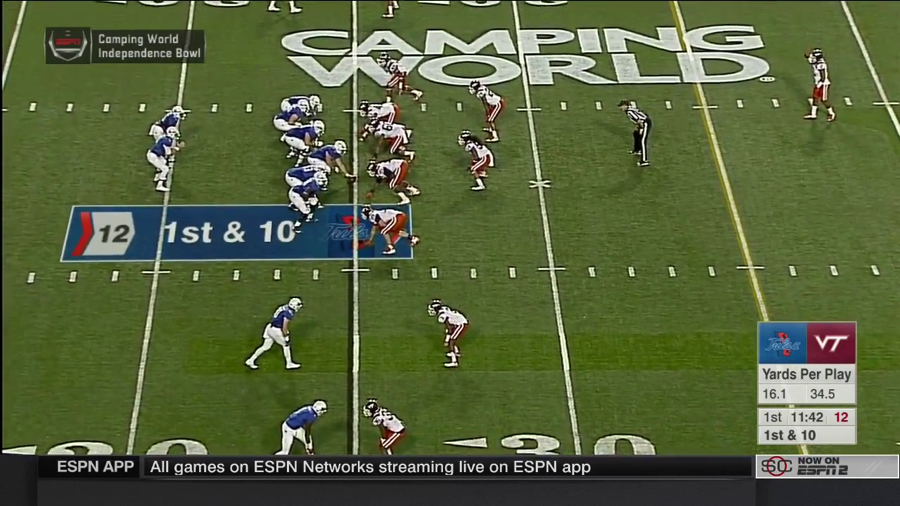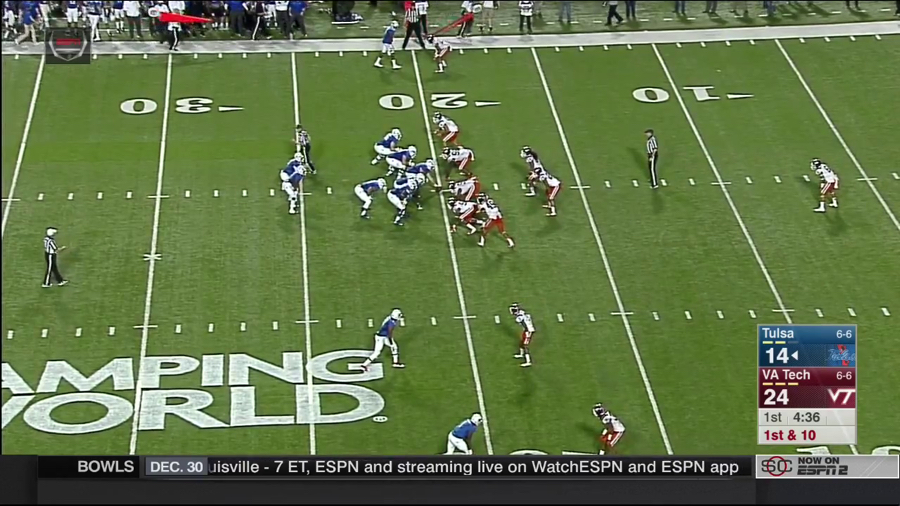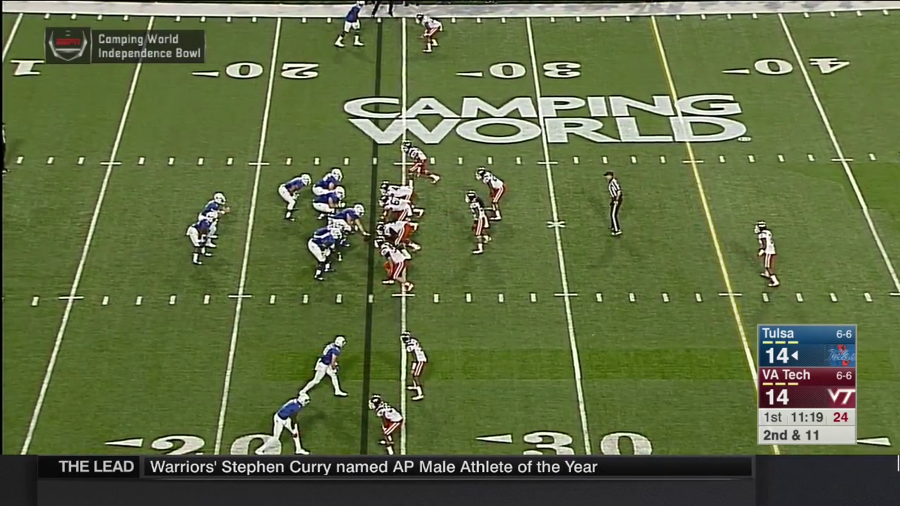Amid some of Virginia Tech's disappointments on national signing day were hints of the continuing advancement of Bud Foster's defense. Tech's defensive targets suggest the traditional role of the d-end and backer in the Hokies' scheme could be evolving.
Throughout the 2015 season, both Mason and I noticed that Foster had a tendency to run the Bear front against 11 personnel (one TE, one RB, three WR formations). At points, his reliance on the Bear was so predictable that teams like Duke and ECU used formation to dictate Bud's personnel groupings and then attack those tendencies with plays like QB power and counter trey. Those runs blocking schemes keyed the Hokie defensive line to slant away from the play, often leaving the linebackers outnumbered and outmuscled at the real point of attack.
Against Tulsa, Foster revised his strategy. Instead of deploying the Bear against 11 personnel, he mixed and matched 40 front alignments.
Here is the traditional G front (a three-technique defensive tackle and a five-technique defensive end to the running strength of the formation). This has been the base defensive line alignment since Foster became the defensive coordinator.

Here is another example of the G front, with the three-/five-technique combination to the running strength. While this is the traditional base defensive line alignment for the Hokies, the backer and the whip are both aligned to the running strength (tight end side) of the formation. Traditionally, the backer has almost always aligned to the boundary with the exception of the Bear front against Ohio State in 2014. (Note, the backer played to the boundary against the Buckeyes in Bear on most snaps in 2015.)

Here is a variation of the Bear front (double eagle 3-techniques and a nose tackle. However, Woody Baron is widened into the A gap.

After reviewing the film of Tech versus Tulsa in the Independence Bowl, I walked away knowing if there was a tight end in the game for Tulsa, the backer and whip would align to his side and the backer would align on the line of scrimmage. I also noted the weakness of the scheme was the damage that could happen if the Hokie defensive line was not gap sound. Motuapuaka and Shegog were not particularly proficient at winning battles against guards at the second level. They needed those defensive linemen to be gap sound and tie up blockers.
Evolution as Evidenced by Defensive End Recruiting
Once I had some time to watch film of the Hokies' recruiting targets, it became pretty obvious Foster may be weighing a move back to the traditional 40 front. It also became apparent Foster really likes something about the alignment of the backer out on the edge to the strong side. Backers like Xavier Adibi would align as a traditional linebacker. Sometimes, the defensive end on the backer side would slant hard to the outside and set the edge, and the backer would be expected to fit in between the end and the three-technique defensive tackle. This would form a wall to cause the running back to cut back right into the arms of the free hitter (usually the mike or the whip). On other occasions, the end would crash inside, and the backer would run outside and set the edge (normally spilling the running back outside to the rover). Backers were long, athletic players who could set the edge.
Spread offenses remove the whip or the rover from the run game, which makes it much more difficult to spill runs to the outside. The alignment of the Bear puts a static defender on the edge, making it much tougher to bounce outside for the runner. Since the spill alley player often is tied up in man coverage, that edge player has more help to the inside, so the formation allows for much more frequent force plays back to the inside free hitters (the mike and the whip).
Because of the alignment, the backer/edge defender has the added responsibility to also squeeze: trap, wham, and counter plays in which a guard or H-Back pulls to kick him out. It requires more strength and a heavier shoulder (the ability to take on a block and squeeze it inside rather than running around the block), than recent backers like Deon Clarke and Tariq Edwards had. Also, with the alignment of the whip to the tight end side, the backer has very little pass defense responsibility. Finally, the Hokies have struggled to recruit linebackers in recent cycles, in part because of the unique responsibilities of a backer in Tech's base defense (the 4-2-5 with or without the whip) versus the responsibilities of a linebacker in a 3-4 or a 4-3 defense. The backer alignment on the edge is more attractive to smaller defensive end recruits with twitch, or linebackers with outside linebacker experience in a 3-4.
To use such a system, the defensive end (especially to the backer side) must be more physically stout against down blocks. Far too often this season too much space opened up between the backer and the defensive end because the end was caved inside too easily and didn't recover. Ken Ekanem improved in this area as the season progressed, and Vinny Mihota was a significant upgrade at the point of attack over Dadi Nicolas in the first half against Virginia.
A closer look at the recruits Foster targeted supports my scheme evolution theory. Jimmie Taylor is a 6-3, 230 pound defensive end who enrolled in January. The first thing that jumps out on Taylor's film isn't any particular skill set. Instead, it is how he was often utilized away from the edge. Often he is aligned at defensive tackle or aligned as a five-technique defensive end.
As a sophomore, Taylor was a bit more gangly and wasn't as smooth as an athlete. However, he was gap sound and physical at the point of attack.
Taylor looked to engage a blocker rather than attack the gap. He initiates contact with the blocker, gets his arms extended to control the blocker, and then sheds him to scrape over to the running back.
As Taylor grew, he continued to be a gap sound player. He also gained more twitch, balance, and fluidity. As a junior (his senior film isn't available on Hudl), he still showed the ability to win physical battles with leverage and technique, as you can see as he defeats this down block. Note, shedding down blocks was a primary bugaboo of the Hokie defensive line last season.
Taylor is a player with a long frame and could add some weight to get even stronger at the point of attack. As he matured, he added some edge speed and better leverage technique. Here is shows off a nice swim move from a defensive tackle alignment.
I like to see the development in Taylor's game, and he is trending the right direction. Still, I don't think any talent evaluator would say that Taylor has terrific burst off the line of scrimmage.
His strength and leverage at the point of attack makes Taylor an asset. Unlike Foster's reliance on quick twitchy edge defensive ends that sometimes struggled to hold up against power blocking, Taylor can fight across down blocks, beat double teams, and get back into the play. Tying up blockers also frees up the Hokie linebackers, who have struggled to get off blocks and make tackles the last two seasons.
When you watch some of the other defensive end targets of Foster late in the recruiting cycle (JaQuan Bailey and Tomon Fox), both were very similar players in stature, skill set, and technique to Taylor. Both kids were 6'2"-6'3" types checking in around 240 pounds. Both kids were strong at the point of attack, and neither demonstrated significant edge rush speed. I believe Foster saw a need to get stout at the point of attack and targeted defensive ends that fit that need.
New Skills and Responsibilities for the Backer Position
Foster targeted backer recruits who fit the skillset needed to play on the edge rather than in a traditional backer alignment. Signee Emmanuel Belmar and targets Chase Pine, Dominique Ross, and Keith Simms were all hybrid players that aligned as stand up defensive ends/outside linebackers in high school. From that alignment, they were required to play with a heavy shoulder to contain the edge, pursue with speed down the line of scrimmage from the back-side on runs away, and get to the quarterback with a disciplined pass rush. All four players are longer (6'2"-6'5" with what appears to be more wingspan) and heavier (230-245 pounds) than Tariq Edwards, Deon Clarke, and (gulp) Lyndell Gibson.
Foster compared Emmanuel Belmar to Nekos Brown, a high school linebacker, who ultimately became a steady contributor for the Hokies at defensive end. Belmar is 6-2, 230 pound linebacker with a frame that could easily play at 240-250 (and Foster noted that he could grow into a defensive end).
In high school, Belmar played a hybrid outside linebacker/stand up defensive end role just like Tremaine Edmunds did against Tulsa. Edmunds, despite his frame, played much more like a traditional linebacker in high school and plays a little stiff on the edge. Belmar appears to be much more fluid on film. He has a really quick first step off the line of scrimmage. While Foster sees Brown in Belmar, to me, he looks very similar to Dadi Nicolas on film. His first step and ability to bend really jumps off the screen, and like Nicolas, he doesn't have ideal size for a traditional defensive end, and doesn't have the look of a guy who can go back and cover like an outside linebacker.
Here, Belmar gets a tremendous jump off the line of scrimmage. The opposition rolls protection away from Belmar, leaving him with a back.
You expect Belmar to win that battle with his size, yet Belmar does a terrific job of sinking his hips without losing his speed. That allows him to get under the pads of the blocker and drive him into the quarterback without losing outside leverage or contain. I regularly hear complaints about the damage running quarterbacks do against the Hokies. Some it was the direct result of defensive ends needing to turn the corner with speed to get to the quarterback because they couldn't win with power. As result, they often ran themselves out of their pass rush lane.
Belmar also plays with a heavy shoulder. In the Bear and base front with the backer walked up, he must maintain outside leverage (keeping his outside arm free) while forcing the running back to the inside. In that role, he can't get pushed too wide or he will widen the alley the free hitter needs to fill to make the tackle. On this play, Belmar uses a nasty rip move to get up the field.
He keeps his outside arm free (in case the back still tries to go wide). When the back commits inside, Belmar doesn't stop playing. He plants and spins himself back to the inside to make the tackle.
Here the offense gives Belmar a free release and tries to wham block him.
Belmar bends inside to avoid the block and make the play. He looks comfortable, fluid, and athletic on the outside and finds the football.
The Total Package: Tyjuan Garbutt
The aforementioned players represent a standard we have seen for two plus decades at Virginia Tech. Foster finds kids that may not have the all-around skills to fit most defensive systems; yet they have a skill set that fits the unique requirements for Foster's system. Taylor and Belmar fit the specific needs of a defensive end that can play on the interior, and an edge player with a heavy shoulder and the twitch to make plays, respectively.
Hokie Nation got a major positive surge of energy when 4-star defensive end recruit TyJuan Garbutt announced his commitment to Tech. The 6-4, 225 pound Riverbend HS product is a playmaker in a Bucky Hodges' role as a runner and slot receiver in their spread offense. His film shows tremendous athleticism and speed for such a big man. On defense, he usually aligns in a stand up role on the edge. He shows much of the same speed and twitch as Belmar with a frame that, when he fills out, can play in a traditional 40 front defensive end or 3-technique roles and stand up to blocking.
This clips shows Garbutt's ability to bend back to the inside.
He has a solid first step, and I think his erect stance with very little knee bend hinders his ability to get off the football. Once he gets one-yard in depth, he has terrific ability to shed the block and bend flat down the line.
On this play, Garbutt crosses the left tackle's face twice as the quarterback pump fakes and then tries to break contain to the outside.
One would like to see more use of leverage technique here, but at the same time the change of direction ability is a real wow factor for a kid that likely will play in Blacksburg around 250 pounds.
Garbutt has absurd straight-line speed for a defensive lineman. On this play, he runs down a screen from behind and closes a 10-plus-yard lead in the process.
Yet, he isn't a long strider, which allows him to change directions and keep his balance, even when being blocked. He can stunt through an inside gap with power like Mihota.
Furthermore, to go with that power Garbutt has the athleticism to eat up space on the edge.
Garbutt gives Foster a player that has the versatility to cause disruption playing in space while at the same time having the power to move inside. I am really excited about his potential, and hopefully he represents a new wave of talent that can fit the scheme while being able to win more one-on-one matchups.
Short term, Foster clearly saw that he had given up too much gap soundness in order to get dynamic edge quickness. With the Hokies behind the 8-ball in the last recruiting cycle due to Frank Beamer's impending retirement, Foster sought players that specifically addressed those weaknesses while being good fits for a scheme where we can expect to see even more of the backer playing on the line of scrimmage. Belmar and Taylor represent those types of players — guys who may not have the all-around skill set to be regarded as elite recruits — yet bring certain unique skill sets to the table that can help the scheme operate more effectively. Garbutt represents the next evolution that we hope to see facilitated through better recruiting and talent. Garbutt can play in a multitude of roles and has a mix of size, speed, and athleticism that the Hokies have not featured at the defensive end spot since Jason Worilds and Chris Ellis roamed the edges. More players like Garbutt can allow Foster to have the best of both worlds — gap soundness through increased size coupled with explosive playmaking ability.


Comments
Please join The Key Players Club to read or post comments.
Please join The Key Players Club to read or post comments.
Please join The Key Players Club to read or post comments.
Please join The Key Players Club to read or post comments.
Please join The Key Players Club to read or post comments.
Please join The Key Players Club to read or post comments.
Please join The Key Players Club to read or post comments.
Please join The Key Players Club to read or post comments.
Please join The Key Players Club to read or post comments.
Please join The Key Players Club to read or post comments.
Please join The Key Players Club to read or post comments.
Please join The Key Players Club to read or post comments.
Please join The Key Players Club to read or post comments.
Please join The Key Players Club to read or post comments.
Please join The Key Players Club to read or post comments.
Please join The Key Players Club to read or post comments.
Please join The Key Players Club to read or post comments.
Please join The Key Players Club to read or post comments.
Please join The Key Players Club to read or post comments.
Please join The Key Players Club to read or post comments.
Please join The Key Players Club to read or post comments.